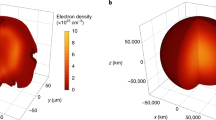Abstract
RESEARCH in the field of high-current gas discharges is now being pursued vigorously1. In these discharges, where the gas is highly ionized, higher spectra can be predominantly excited (for example, O III, A II) and the pinch effect reduces the loss of ions to the walls. It is thus interesting to consider the possibility of detecting in the laboratory those forbidden lines which are of astrophysical importance.
Similar content being viewed by others
References
Ware, A. A., Phil. Trans., A, 243, 197 (1951). Kurchatov, I. V., J. Nuclear Energy, 4, 193 (1957). And others.
Nagaoka, H., and Futagami, T., Proc. Imp. Acad. Japan, 8, 78 (1932).
Emeléus, K. G., Sloane, R. H., and Cathcart, E. B., Proc. Phys. Soc., Lond., 51, 978 (1939).
Aller, L. H., “Gaseous Nebulae”, 166 (Chapman and Hall, Ltd., London, 1956).
Author information
Authors and Affiliations
Rights and permissions
About this article
Cite this article
KAUFMAN, S. Multipole Radiation from High-Current Gas Discharges. Nature 180, 1345–1346 (1957). https://doi.org/10.1038/1801345a0
Issue Date:
DOI: https://doi.org/10.1038/1801345a0
- Springer Nature Limited





